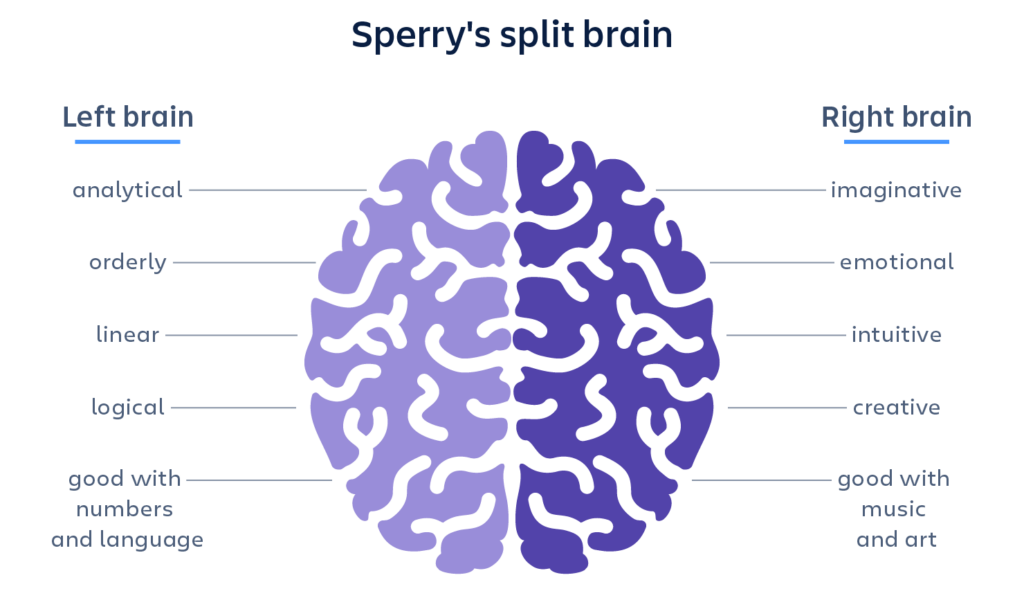We’re trying something new here, letting me/Lyndon write an email (turned blog post) 🤨 (commenting “more Lyndon” would do wonders for my self-esteem).
For those of you who have never had many interactions with both of us, I like to explain the differences between Jo and me as the somewhat over simplified left brain vs right brain split brain theory:

Since most recent emails have come from Jo I’m pretty sure you can easily pick up that she’s the right-brain part of our business and I’m the left-brain.
We’re going to try out adding a second email each week (until we get too busy that it’s unsustainable), where we’ll take a look at a topic we’re chatting about with our coaching clients, a case study of something in the news, or breaking down a recent change we’ve made, as a way of sharing a deeper look into the types of conversations Jo and I have and what we’re currently learning that you can be applying to your life & business as well.
As it’s still (almost) the beginning of the new year, I thought we’d start with time management. With basically every coaching client that we’ve chatted with over the last couple of months, at some point the question has been asked — how can I better manage my time to get things done?
In case you need convincing that good time management can make a huge difference, let’s look at some quick numbers. If (hypothetically) you were able to save or give yourself back 10 minutes a day Monday to Friday, that would equate to 50 minutes a week or 2400 minutes for the rest of 2024, which equates to 40 hours or 1 whole workweek.

TL;DR saving 10 minutes every workday adds up to saving an entire workweek by the end of the year.
Yeah, it kind of blew my mind when I did the math as well.
This directly leads us to two questions, of which I can only help you with the first:
- How to better structure your time?
- What will you do with all your freed-up time? Maybe pick up a new hobby, go for a walk (it turns out it’s good for you), call your mom, just please anything but mindlessly scrolling TikTok.
We usually structure our advice for time management in a Good, Better, Best format when we’re talking with clients because of the amount of effort required for each, along with how big of a difference it could make for you. We also recommend stacking these, because they work well to do in combination depending on what you’re struggling with at the moment.
Starting with the Good – Weekly Retrospectives, we “stole” this almost directly from the Agile Methodology (we recommend the book SCRUM: The Art of Doing Twice the Work in Half the Time if you want to go deeper). Start having a Friday “log-off” or Monday “kick-off” meeting with yourself to look back at what you accomplished (ahem celebrate), take note of where you need to double down, and plan out the next week.
This should be a quick 10-30 minute process. The idea is to have clarity for yourself on what you’re spending your time on. So that when you have a free 20 minutes on your calendar instead of just getting distracted you can directly pick up the next thing on your to-do list for the week.
The weekly retrospective consists of 3 questions:
- What did I complete last week?
- Where did you get stuck or need more time than you thought you would?
- What am I planning to do in the upcoming week? (both scheduled things & self paced things)
As you get more practice doing this you’ll be able to calibrate for yourself how much you can actually get done in a week, and commit to the right amount each week.
The Better – good old Time Blocking and Time Boxing – and yes they are different. But we recommend using both as a way of simplifying the game of calendar Tetris that we all play every week.
Time Blocking at its core is about blocking out distractions so that you can deeply focus on things that take a chunk of time to complete. Generally, how this works is you choose a day of the week, or mornings/afternoons to block off your calendar from calls, interruptions, and ahem social media/email distractions. Some people find it easier to assign specific things to be done in each time block (eg content creation, client work, etc), while other people use this to knock out as much from their weekly list of things to be completed (see how weekly retrospectives & time blocking work well together here).
Time Boxing is about preventing unnecessary time being spent on tasks that can end up taking a ton of time if you let them. So put on your calendar say 1 hour to work on a specific thing, and at the end of that hour you stop, if it’s good enough call it done, if it needs more it can be scheduled again, but this is about preventing a little task from expanding to take up your whole day. In all seriousness, for like 95% of things, done is better than perfect. It’s just really easy to get lost in the weeds.
The Best – Audit your time – woah, woah, I know that sounds intimidating, but it’s pretty easy. The benefit of going through the effort is you can get a clear picture of where your time is being spent, how many different directions you’re getting pulled in, and how you can start batching/automating/outsourcing some things to be more efficient.
How does it work:
- Get sticky notes and a wall you can put them on – we find this does better if it’s in your eye line everyday
- Designate 2 weeks that represent “average” work weeks for you (we know average doesn’t exist, but give it a shot)
- For those 2 weeks, write on a new sticky note Every. Single. Thing. You. Do. – Did you attend a meeting, send a proposal, follow up with a potential client, run to the post office, check in with your contractor, record a reel, and then come back to edit that reel? – you’re gonna have A LOT of sticky notes on the wall by the time you’re done (and yes you’ll have lots of repeats, each time you do something it gets a new sticky note)
- Organize them into categories that make sense to you (eg, client/sales/admin, or communication/content/travel, etc) – where are you spending most of your time?
- Once you’re all done ask yourself 3 questions:
- What tasks can I stop doing and it won’t affect my biz at all? – cut them out right away, just cause you started doing something weekly years ago doesn’t mean you still need to be doing it weekly
- What can I do more efficiently? – batch, automate, create a template/SOP
- How can I save time & money by outsourcing things that aren’t in my zone of genius? – this would free you up to do more of what you’re good at and make more money
Whelp this started as a simple quick email about how to save time and you’re probably around 5 mins into readying this (the average person reads at 238 words per minute, and we’re at ~1200 words). Thanks for going on this ride with me.
In case this wasn’t enough I just picked up a new book on productivity, Feel-Good Productivity: How to Do More of What Matters to You, so once I get it scheduled into a Time Block I might have even more fun ideas for you.
Since we’re trying out something new here I’d appreciate it if you comment below and let us know what you think: are we excited about this series, should it be more bite-sized, any topics you’d love me to go deep on, or should I pivot to TikTok dance videos (sadly not happening 😭)?





Comments +